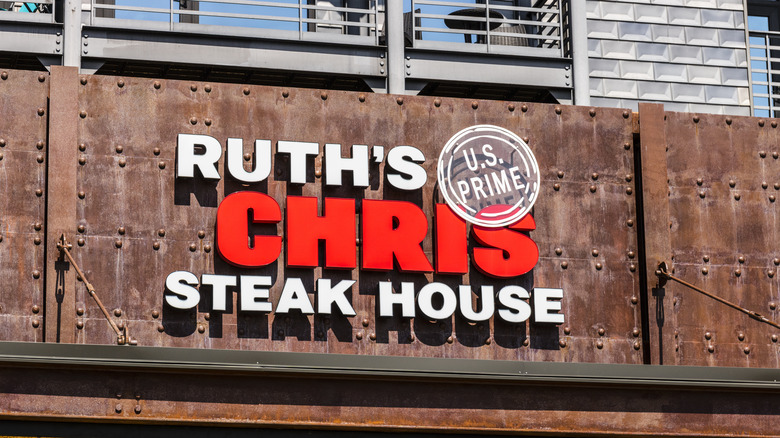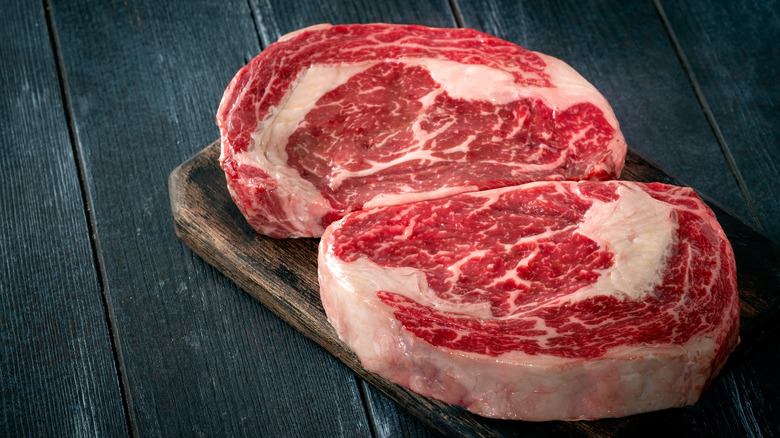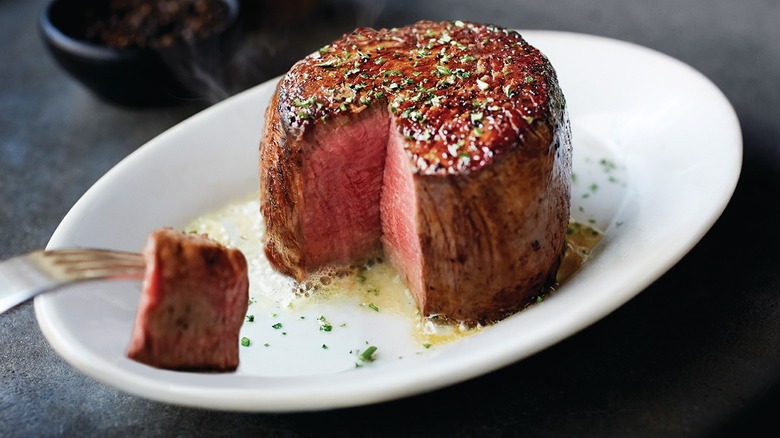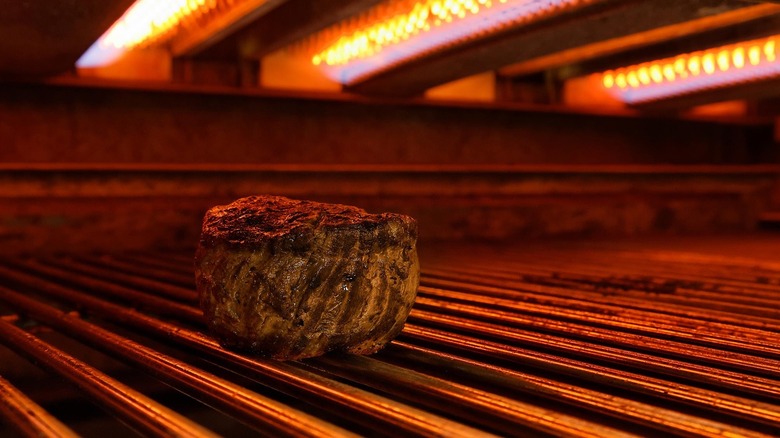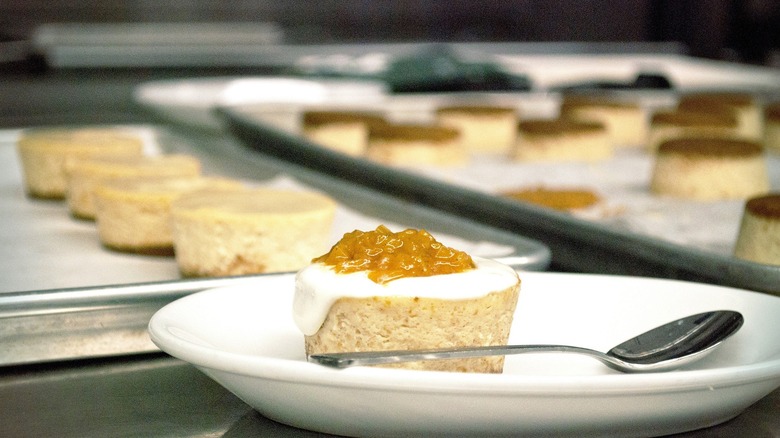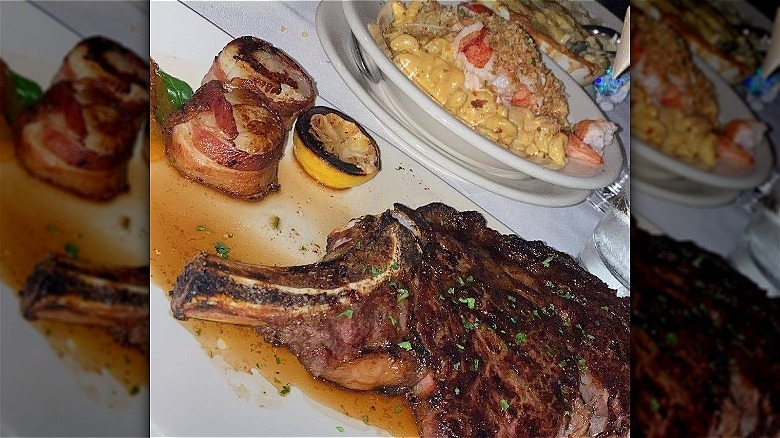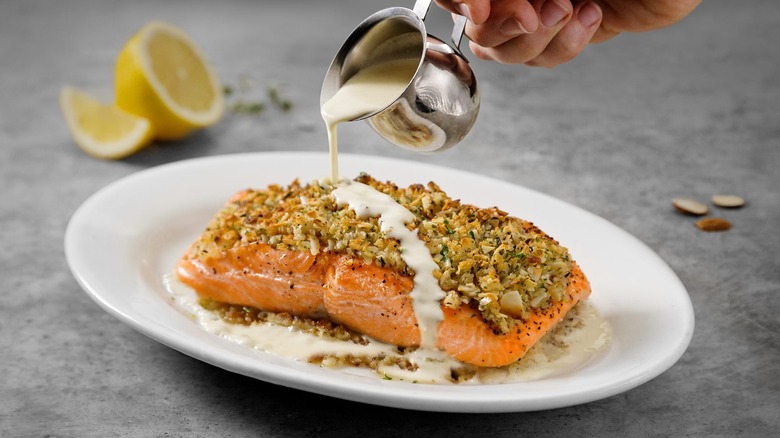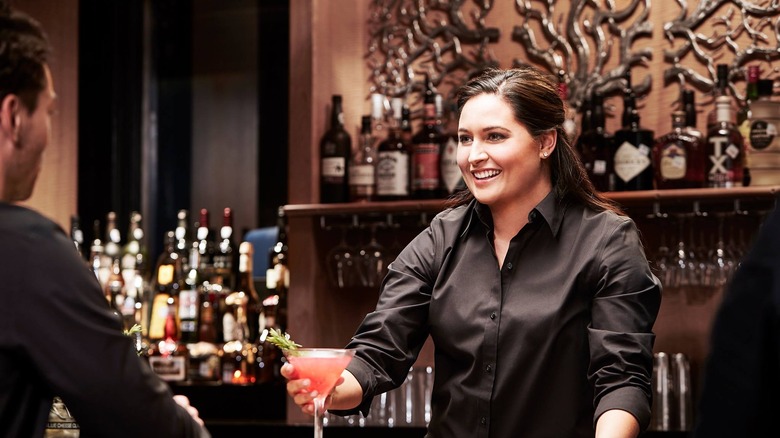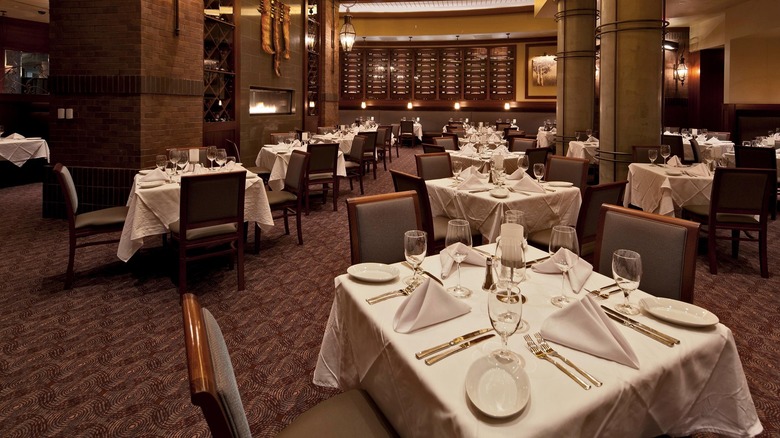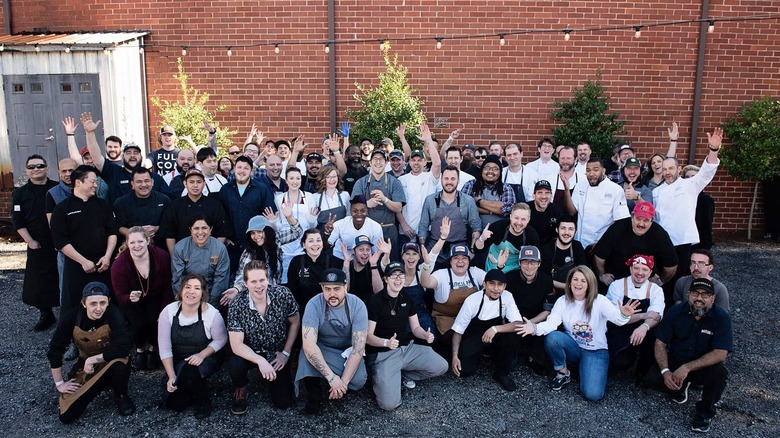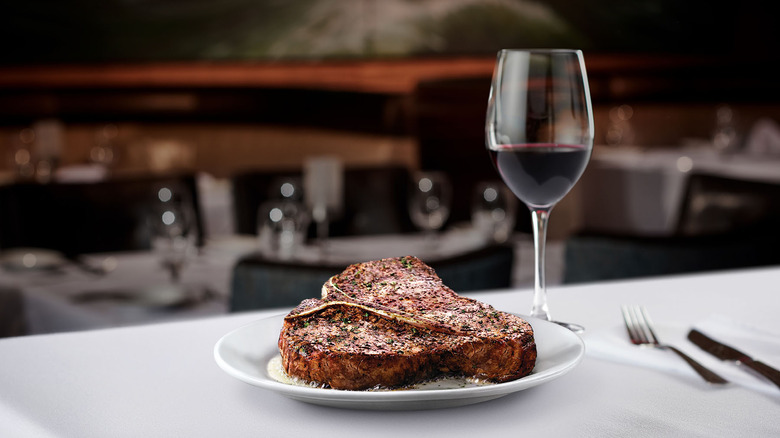The Real Reason Why Ruth's Chris Steak House Is So Expensive
When Ruth Fertel mortgaged her home to buy Chris Steak House in 1965, she probably didn't expect to launch a culinary empire in the process. Following its transformation into Ruth's Chris Steak House in the 1970s, the New Orleans-based restaurant embarked on a unique path to become of the nation's top dining establishments. Visit any of the 100+ outposts around the U.S., and you'll find a consistent pattern of elegant ambiance, solid customer service, and a bountiful supply of premium meats grilled and seasoned to perfection. The herb-infused butter pat and heated plates (500 degrees, to be exact) have become signature parts of the experience.
Of course, anyone who's dined at Ruth's Chris knows it's pricey enough to set your wallet back and then some. The chophouse famously sold $5 steaks on its first day in business (per Fertel.com), but diners today can expect to pay in the double-digits for cuts of the cow, and that's before the sides are added. As noted by Restaurant Business, efforts have been undertaken to draw in younger crowds normally outside the typical steak house demographic. But a menu of bar snacks won't change the fact that dining at Ruth's Chris Steak House is going to cost you. If you've ever wondered why Ruth's Chris Steak House is so expensive, read on to find out.
Only the highest quality meat is used
Besides the signature pat of butter, one thing is guaranteed for a Ruth's Chris steak: It's not going to come from the grocery store. In fact, the upscale steakhouse chain takes pride in selecting the finest cuts for its establishments, consistently delivering first-rate chops no matter the location of the restaurant. According to the Ruth's Chris website, the beef is certified Prime by the U.S. Department of Agriculture and is sourced from cattle ranches across the Midwest.
What constitutes Prime? Under 2% of all U.S. beef meets the stringent standards for a Prime designation (via The Spruce Eats). The animals are typically young and fed a specialized diet (a blog post from Ruth's Chris states the cows are corn-fed), which results in a better-tasting steak. The meat is also distinct in terms of look and texture — Prime beef displays visible webs of fat and has a tender consistency, factors that both lend themselves well to grilling (per the USDA). Lower-grade selections, like Choice or Select, just can't compare. It's clear that meat production is a costly venture, and Ruth's Chris' hands-on approach to selecting high-quality beef requires work. The bill at the end of your meal factors in the labor taken to source, purchase, prepare, and serve any steak you order from the restaurant.
Ruth's Chris' steaks undergo a lengthy aging process
Part of what makes the steaks at Ruth's Chris high quality and, therefore, expensive, is how they are handled. For one, the steaks never see the inside of a freezer (per Ruth's Chris' official website), and for two, they undergo an aging process that enhances their flavor. Wet-aging, as Lone Mountain Wagyu explains, involves refrigerating meat in a tightly-sealed bag until it's time to cook it. While the steak is sitting in its own juices, the enzymes inside the flesh break down the meat, making it tender and juicy. This is worth it for the killer steak you get in the end, but it'll require some patience to get there. Depending on the cut, Ruth's Chris ages its steaks from 14 to 28 days.
Technically, wet-aging is cheaper than its alternative — since less moisture is lost, there's a higher quantity of meat to sell. That's why Ruth's Chris switched from dry-aging to wet-aging in the first place. However, the process still requires time and fridge space. Time is money, as the age-old saying goes, so aging the steaks contributes to Ruth's high prices.
Ruth's Chris uses expensive equipment
Let's face it: Your typical backyard grill just can't compete with a steak house broiler. That's because the grill-masters at Ruth's Chris use state-of-the-art equipment to sear, roast, and sizzle every cut of meat that comes through its kitchen. As users on Quora discuss, the steak house famously uses infrared broilers to give its steaks a beautifully-seared exterior. Per Dine Magazine, Ruth Fertel designed the first broilers herself. They are cranked up to 1800 degrees Fahrenheit, which is not exactly a feat the average home broiler could achieve.
Today, restaurant supplier The Montague Company lists Ruth's Chris as a client. A Montague C45S Broiler, which is the model allegedly used by the chain (via Reddit), goes for over $16,000 on Kitchen Restock. That's a staggering amount, but these broilers have to cook a whole restaurant's worth of steaks all day, every day without breaking. Investing in quality kitchenware adds to the price of the food at Ruth's Chris Steak House.
Many items are made from scratch
We know by now that Ruth's Chris doesn't skimp on quality when it comes to its main attraction, the meat. So how does the rest of the menu stack up? It turns out, the chop house doesn't pinch pennies on the sides, either. In an Ask Me Anything (AMA) on Reddit, a self-proclaimed Ruth's Chris employee revealed that all the desserts were crafted on-site and by hand. Meanwhile, the mashed potatoes are put through a potato ricer and mixed with butter and milk (per What's Up? Media), resulting in pillowy spuds that are light as air.
Compared to the frozen sweets shipped in bulk by restaurant suppliers, a freshly-baked cheesecake will always cost more. In addition to the time and labor put into preparation, there's the matter of raw ingredients, which can spoil and waste a restaurant's money. ReFED reports that about $25 billion in waste is created by restaurants annually. Ruth's Chris' commitment to house-made sweets and sides raises its costs, which in turn means you have to pay more.
The portions are huge
When visiting a fancier establishment, it's nice to get some bang for your buck. While it's tempting to avert your eyes from the sweat-inducing dollar signs looking back at you from the menu at Ruth's Chris, there is a notable trade-off to paying more, and that's the portion size. Simply put, the portions are huge. A meal at Ruth's Chris Steak House might set you back a day's wages, but you'll get pounds of delicious meat in return.
One thing to keep in mind at Ruth's Chris is that many of the entrées are intended for sharing. Real Menu Prices lists a porterhouse steak for two at $92 (Ruth's Chris doesn't display menu pricing online). That amount of money could theoretically cover dinner for four at Outback, tax and Bloomin' Onion included. However, that's leaving out the fact that the Ruth's Chris steak is a 40-ounce piece of meat and is literally intended to be eaten by two people, as the name suggests. Splitting one lands at $46 per person, which isn't bad considering a 22-ounce porterhouse steak at Outback goes for $37. Steak is expensive, but for the amount of meat you get, the prices at Ruth's Chris aren't outrageous.
Local ingredients add up
According to The Washington Post, it's more expensive to buy produce from the farmer's market than from the grocery store. Due to the cost-efficient perks industrialized farms benefit from, such as large-scale equipment for growing food in bulk, they can charge less for food than smaller farms are able to (via Food & Wine). For this reason, seasonal or local ingredients merit a significantly higher price point than their industrially-produced equivalents.
It's true the meat-centric menu at Ruth's Chris hasn't changed much in the last 50 years; steak and potatoes seem to hold an enduring appeal. What has changed is consumers' tastes for regional, locally-sourced meals. Maui Restaurants Blog praised a location in Kihei, Hawaii for serving locally-sourced vegetables from the Kula region, while a restaurant in Asheville, North Carolina sought to incorporate area businesses like bakeries and coffee roasters into its menu (per Mountain Xpress). Sourcing food from local producers is a good move for the steakhouse, but it contributes to the hefty dollar amounts on the menu.
Employees are highly valued at Ruth's Chris Steak House
Ruth's Chris takes care of its employees. A list of benefits shows staff members can receive health insurance, vacation, retirement, and disability (via Ruth's Chris Steak House). Additionally, employees can access extensive training programs, including leadership development and opportunities for job growth within the company.
Offering these benefits might be expensive, yet in the case of Ruth's Chris, it's an investment that only grows over time. In 2019, Ruth's Hospitality Group CEO Cheryl Henry recalled a story involving a young cook who worked at the steak house back when Ruth Fertel was in charge. As Henry told the crowd at the ICR Conference, the employee was experiencing a rough time at home, and Fertel extended him some grace by giving him a weeklong paid vacation to regroup. The result? He prospered in the company, working their way up to the top spot in the chain's culinary operations department, according to Restaurant Business. For Ruth's Chris, retaining employees for the long haul is a worthy investment, and you're paying for that as a customer.
Customers pay for the experience
One of the key reasons why Ruth's Chris Steak House is so expensive is obvious: you're paying for the experience. Think about what you're looking for when you visit a fancy restaurant. It's not just the convenience of having food prepared for you, though that's certainly a major part of it. It's also the high standards practiced by the establishment. Is the dress code formal? Is the dining room clean and attractive? Are the servers properly attired, cordial, and professional? Throw in the leather-bound menus and wine recommendations, and it's clear that the ambiance offered by a steak house is special. High-end steak houses also make impressive backdrops for business deals. As one Reddit user who's worked at Ruth's Chris put it, "It's known for being a high-end steakhouse, therefore a lot of companies go there and throw around their money."
Perhaps you could grill your own porterhouse at home. You could even sizzle some butter in the pan for kicks and pour some merlot to make yourself feel fancy. But you would need to do the work yourself in preparing the meal, from grilling and seasoning the meats to crafting the side dishes and dessert. At Ruth's Chris, you're paying for the luxury of having other people do all that work for you.
Ruth's Chris Steak House gives back to others
Per the National Restaurant Association, restaurants contribute $3 billion annually towards charitable causes. Ruth's Chris Steak House is no stranger to philanthropy. Over the years, the restaurant has poured thousands of dollars into combatting social issues throughout the local community, with non-profits targeting hunger, child abuse, and societal neglect (via Ruth's Chris Steak House). Atlanta-area locations support the Giving Kitchen, donating $50,000 between workers and the restaurant itself.
Ruth's Chris also offers donation matching on gift cards. According to the company, customers who purchase a gift card of at least $25 to use for a charitable event at the restaurant will have the value matched by Ruth's Chris. The maximum for this offer is $250. No numerical cost could ever convey the value of helping others. That doesn't mean it's not a business expense, however, and anything that costs the business money will ultimately affect prices for consumers.
Steak houses like Ruth's Chris are expensive to run
Ruth's Chris Steak House justifies its high price because it's a steak house. A really nice steak house, at that. Keep in mind that in addition to the overhead costs any restaurant needs to consider (rent and utilities, for instance), Ruth's Chris specializes in a pricey product that drives up the cost of doing business. St. Louis Magazine says that most restaurants try to keep their ingredient budget at around 30% of what they charge diners for finished dishes. Because beef and seafood are so expensive, steak houses often spend closer to 40%, so they actually make a lower profit margin on their food than other restaurants do.
As commenters on Quora discuss, steak houses like Ruth's Chris also rely on culinary expertise and ambiance to draw guests through their doors. When you buy a meal at Ruth's Chris, you're not just paying for the steaks; you're also paying for skilled chefs to cook them, waitstaff to serve them, and the elegant surroundings that comprise the whole package. Customers will foot the bill so long as they receive the upscale service they've been promised.
